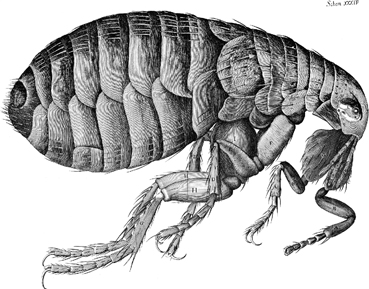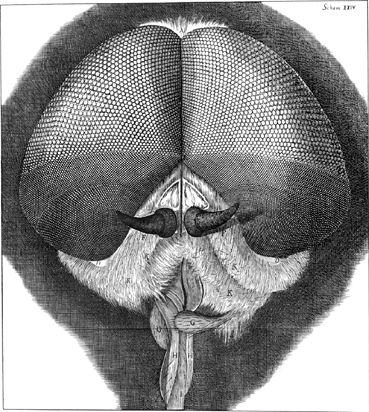Fig. 6.1
Hooke’s drawing of the microscopic appearance of cork in Micrographia. He was the first person to use the word cell. From [10]
However the most interesting parts of Micrographia deal with his drawings of small animals. One of the most striking is the flea shown in Fig. 6.2. The draftsmanship and attention to detail is outstanding. Of course we should appreciate that what we see here is an engraving based on Hooke’s drawing. But it is a superb illustration. Hooke goes on to relate structure and function when he states “For its strength, the Microscope is able to make no greater discoveries of it than the naked eye, but only the curious contrivance of its leggs and joints, for the exerting that strength, is very plainly manifest, such as no other creature, I have yet observ’d, has anything like it”. In other words he infers the jumping ability of the flea from its anatomy. But the climax of Hooke’s drawings is perhaps the head of a grey drone-fly with the compound eyes as shown in Fig. 6.3. What a magnificent example of draftsmanship this is. Hooke concedes that he has little notion of the function of the various structures but he is clearly obsessed with the sheer beauty of the insect.

Fig. 6.2
Hooke’s drawing of a flea in Micrographia. He pointed out that the many-jointed structure of the legs explained the extraordinary ability of the flea to jump. From [10]

Fig. 6.3
Head of a grey drone-fly (Eristalis tenax) drawn by Hooke in Micrographia. The compound eye shows exquisite draftsmanship. From [10]
Towards the end of Micrographia Hooke has a section on “A new Property in the Air…”. The link between this discussion and the earlier microscopic images seems tenuous. However Hooke describes the inverse relationship between pressure and volume in a gas that we normally know as Boyle’s law, and of course he was working with Boyle on the air pump when the relationship was first described. He uses this to speculate on the weight of the atmosphere. He then goes on to describe the large number of stars discoverable by the telescope, and also some features of the moon. The only obvious link between this discussion and the rest of the book is that a telescope uses glass lenses just as does a microscope.
The images in Micrographia can be revisited many times with pleasure. The famous diarist, Samuel Pepys (1633–1703), recorded that in January 1665 he stayed up until 2 o’clock in the morning reading Micrographia which he called “the most ingenious book I read in my life”. A convenient version of the book was produced by Project Gutenberg and is now on the Web at http://www.gutenberg.org/ebooks/15491. This includes fine reproductions of the illustrations.
6.6 Mechanical Inventions
One of the most extraordinary features of Hooke was the prolific number of inventions that are attributed to him. These are referred to in his diary [18], the History of the Royal Society [2], and Hooke’s various writings. Some authorities state that his inventions number over 1,000. It was noted above that Hooke showed an interest in engineering from an early age, and Fig. 4.3 in Chap. 4 with its drawings of the components of the air pump clearly shows Hooke’s interest in the technical features of the machine.
Timekeeping. This was a major interest of Hooke. First he worked extensively on the pendulum which was also an interest of other scientists at the time such as the Dutchman Christiaan Huygens (1629–1695). Hooke studied the isochronicity of the simple pendulum, that is the conditions under which its period remained constant. For example, he studied the effect of altitude and gravity on the period of swing. He also worked extensively on the conical pendulum in which the bob describes a circle. A particularly interesting invention was Hooke’s so-called long pendulum. The entry for May 6, 1669 in the History of the Royal Society [2] states that “Mr. Hooke produced a new kind of pendulum of his own invention, having a great weight appendant to it, and moved with a very small force; viz. by such a contrivance, that a pendulum of about fourteen feet long, so as a single vibration of it is made in two seconds, with an excussion [excursion] of half an inch or less, having a weight of three pounds hanging on it, and moved by the sole force of a pocket watch… shall go 14 months…”. It seems very counterintuitive that such an enormous pendulum could be maintained swinging for so long by means of the minute power of a pocket watch but this is the case. There is a working model of this pendulum in the Science Museum in London, and the author made a smaller model 12 feet long which is swinging in his study.
Of more practical importance was Hooke’s invention of a pocket watch in which the mechanism was a coiled spring attached to the arbor of the balance. However this became a topic of great controversy. The history is complicated but Hooke apparently considered taking out a patent early on but held back because of a technical issue. Some 15 years later Huygens had the same idea and did acquire a patent which annoyed Hooke immensely. There was a great deal of controversy which even involved the king himself. In fact many scholars now believe that Hooke did have priority with this critically important development in timekeeping. One of the reasons for its importance was that it could be used to determine the longitude of a sailing ship. This depended on having an accurate timepiece so that the time when the sun reached its zenith could be accurately determined. From this the longitude was easily determined. Clocks in which the rate was determined by a pendulum were generally not accurate on a ship because of the rolling motion.
Hooke’s interest in the properties of springs has already been alluded to. He is credited with inventing the spring balance which is still extensively used. Here the weight in the pan determines the extension of the spring, that is, as the weight so the extension (in Latin, ut pondus, sic tensio). Later this was modified to Hooke’s law, that is the extension of the spring is determined by the force (ut tensio, sic vis).
< div class='tao-gold-member'>
Only gold members can continue reading. Log In or Register to continue
Stay updated, free articles. Join our Telegram channel

Full access? Get Clinical Tree


